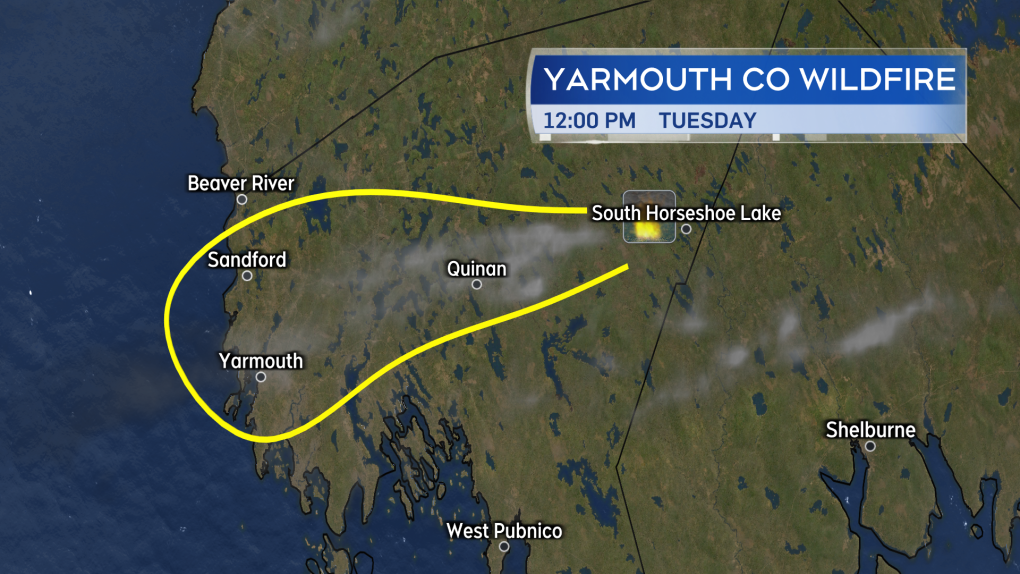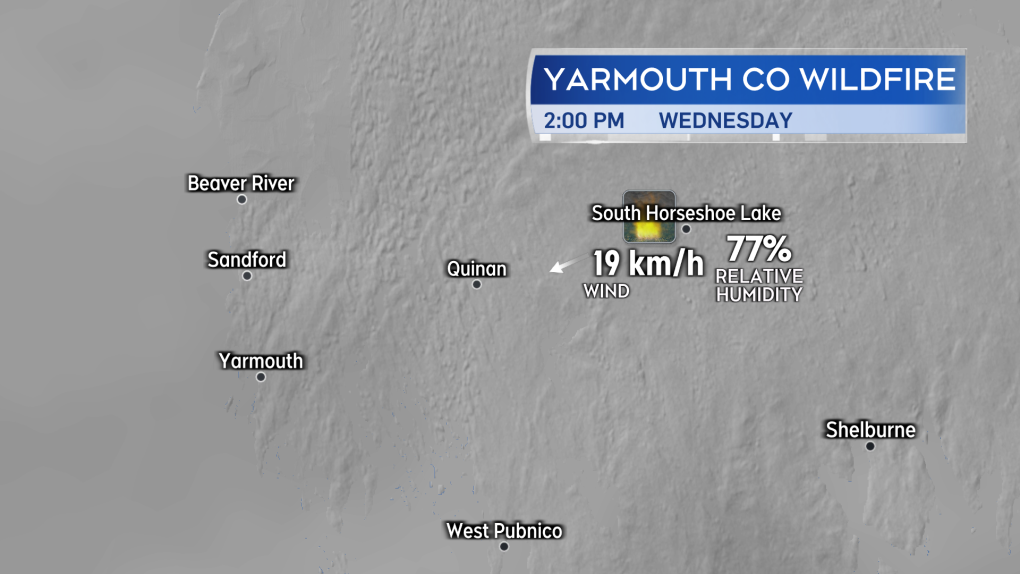Wildfire in Yarmouth County continues to grow; air quality alert in effect
Emergency crews in Nova Scotia are battling a wildfire in Yarmouth County.
At around 8:50 p.m. Tuesday, the Department of Natural Resources tweeted the fire was covering an estimated 1,000 hectares of land.
The Department of Natural Resources first tweeted about the fire at 10:20 p.m. Monday. At the time, it said crews were responding to a wildfire about two kilometres west of South Horseshoe Lake, and that the fire was estimated to be about 50 hectares.
Tuesday morning, DNR said two helicopters and 12 DNR crew members had returned to battle the fire, and that winds and low humidity were causing it to spread.
Just before 2:30 p.m. Tuesday, DNR said the fire near Horseshoe Lake had grown to 200 hectares and was 10 per cent contained.
Just over two hours later, in a news release from the province, it said the estimated size of the wildfire had grown to about 350 hectares and continued to grow larger.
Crews from Shelburne and Yarmouth and two helicopters remain on scene.
Kara McCurdy, the wildfire prevention officer with the Department of Natural Resources and Renewables, says the biggest difficulty for crews is gaining access to the fire, which is burning in a remote area.
"The area is mostly accessible by all-terrain vehicle or trails by walking, so there's no way you can get a vehicle in there to fight the fire easily,” she said. “So, they're having to air-lift equipment in and personnel onto the fire.”
McCurdy says the fire remains under investigation, but officials can confirm there has been no lightning lately that may have caused the blaze.
"We can pretty much peg it down to a human-caused fire, but it is still under investigation," she said.
So far, there have been no evacuations ordered in the area or any structures affected by the wildfire.
"We're keeping an eye on a couple of camps in the area and did some protection on them, but nothing has been lost at this point," she said.
Video taken near the fire Monday night and submitted to CTV News shows thick, dark clouds of smoke lingering over the area.
No burning is allowed in Queens, Shelburne or Yarmouth counties.
Burning was restricted in all other Nova Scotia counties until 7 p.m. Tuesday.
"Nova Scotians should check burn restrictions online or call the toll-free phone line at 1-855-564-2876 (BURN) before starting a fire," said the province in a release Tuesday.
SUPPORT FROM NEWFOUNDLAND AND LABRADOR
Support to fight the wildfire arrived from Newfoundland and Labrador Tuesday, as the province sent a CL-415 water bomber for assistance.
In a news release from the Nova Scotia government, it said assistance was requested through the Canadian Interagency Forest Fire Centre.
"Nova Scotia is a member of a mutual aid and resource-sharing agreement which ensures all provinces and territories will receive help fighting forest fires when needed," said the province.
At around 8:50 p.m. Tuesday DNR said the bomber had arrived and was dropping water on the scene until dark.
AIR QUALITY ALERT FOR YARMOUTH COUNTY
Environment Canada has issued a special air quality statement for Yarmouth County.
An easterly wind will continue to blow smoke from the wildfire towards Quinan and Yarmouth Tuesday afternoon and evening.
In the statement, the department cautions that people who are exposed to the smoke, particularly those with respiratory conditions, may experience coughing, throat irritation, headaches or shortness of breath.
The wildfire has produced enough smoke that it is visible on some weather satellite imagery.
 The fire has produced enough smoke that Kalin Mitchell has been able to see it on some weather satellite imagery in the CTV Atlantic Weather Centre Tuesday. It shows here as grey.
The fire has produced enough smoke that Kalin Mitchell has been able to see it on some weather satellite imagery in the CTV Atlantic Weather Centre Tuesday. It shows here as grey.
CTV Atlantic Chief Meteorologist Kalin Mitchell said conditions were not favourable for combatting the wildfireTuesday, as the wind remained steady out of the east between 20 and 30 kilometres per hour into the evening. He says gusts were between 30 and 50 kilometres per hour Tuesday afternoon.
“The air is also very dry in the Maritimes at the moment,” said Mitchell. “Relative humidity in the vicinity of the fire, and in general in the southwest of Nova Scotia, is only in the range of 20 to 30 per cent. Dew point temperatures -- a measure of moisture in the air -- are below zero, which again indicates the nature of the air in place for the region is generally dry. No precipitation is expected Tuesday afternoon, evening, or night.”
 A blustery, east wind and dry conditions are forecast to persist into Tuesday evening.
A blustery, east wind and dry conditions are forecast to persist into Tuesday evening.
Mitchell said there would be a slight improvement in conditions for fighting the fire in the forecast for Wednesday.
“Weather conditions will be mostly cloudy with the easterly wind forecast to ease into a range of 10 to 20 kilometres per hour,” he said. “Relative humidity is expected to rise into a range of 70 to 85 per cent.”
There is a 40 per cent chance of showers for the area through the day on Wednesday, though a significant amount of rain is not expected.
 Some improvement for fire fighting conditions Wednesday. Cloudier with the wind easing by near 10 km/h. Relative humidity will increase and there is a low (40 per cent) chance of showers
Some improvement for fire fighting conditions Wednesday. Cloudier with the wind easing by near 10 km/h. Relative humidity will increase and there is a low (40 per cent) chance of showers
Natural Resources and Renewables rates much of Nova Scotia as being in a moderate-to-high fire weather index.
CTVNews.ca Top Stories

NEW Health data collected from Indigenous Peoples in Canada has a dark history. One Indigenous company is turning that around
Software company Mustimuhw Information, which develops medical records systems built on a foundation of Indigenous traditions and values, is allowing health providers to capture data informed by cultural practices.
Hezbollah handed out pagers hours before blasts, even after checks: Reuters
Lebanon's Hezbollah was still handing its members new Gold Apollo branded pagers hours before thousands blew up this week, two security sources said, indicating the group was confident the devices were safe despite an ongoing sweep of electronic kit to identify threats.
Cognitive decline reduced by MIND diet, especially for women and Black people, study finds
Following the MIND diet for 10 years produced a small but significant decrease in the risk of developing thinking, concentration and memory problems, a new study found.
'It's disgusting': Quebec minister reacts after body of boy, 14, found near Hells Angels hideout
The province's public security minister said he was "shocked" Thursday amid reports that a body believed to be that of a 14-year-old boy was found this week near a Hells Angels hideout near Quebec City.
Ontario man to pay $1,500 surcharge after insurer says his SUV is at higher risk of theft
An Ontario man says it is 'unfair' to pay a $1,500 insurance surcharge because his four-year-old SUV is at a higher risk of being stolen.
Federal firearm buyback program has cost $67M, still not collecting guns after 4 years
The federal firearm buyback program has cost taxpayers nearly $67.2 million since it was announced in 2020, but it still hasn't collected a single gun.
No, these viral purple apples don't exist in Saskatchewan
If something looks too good to be true, it might be. That's the message from Saskatchewan horticulturists after customers have come into their stores hoping to buy purple apple trees this month.
The Royal Canadian Mounted Police has lost 205 firearms since 2020, including machine-guns
The Royal Canadian Mounted Police has lost 205 firearms since 2020, including more than 120 handguns and at least five fully automatic weapons like machine-guns.
Influencer couple denies leaving kids alone on cruise
For most people, dinner on a cruise ship is a time to relax. But when influencer couple Abby and Matt Howard decided to kick back with a dinner à deux, they ended up kicking up a storm.

































